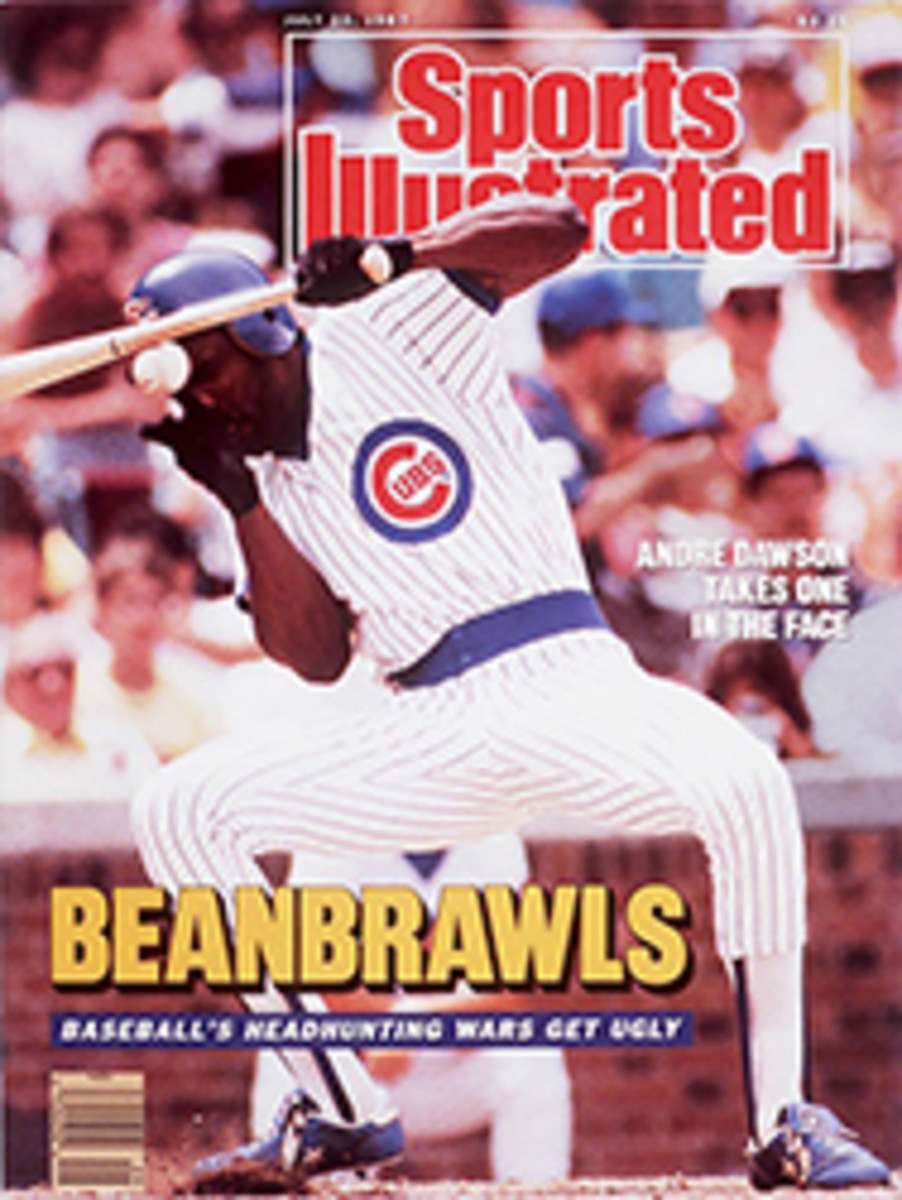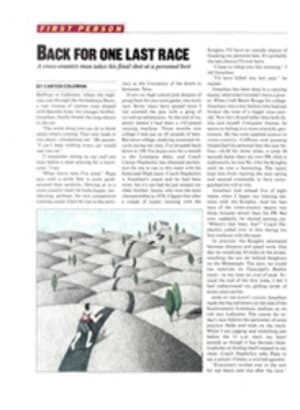
IT'S WAR OUT THERE!
To appreciate just how dangerous the war over the inside corner has gotten in major league baseball, one had only to be at Wrigley Field last Tuesday as the Cubs' Andre Dawson lay barely conscious in the batter's box. In the first inning, Dawson had drilled Padre pitcher Eric Show for his 24th homer of the season, and now, two innings later, Show had drilled Dawson with a head-seeking, 90-mph fastball. The beaning opened a gash in the All-Star outfielder's left cheek that would take 24 stitches to close. Dawson was down for three minutes, while four dozen players had at each other on the Chicago sod.
Only hours after the melee in Chicago, another erupted in Cleveland. This was touched off by an up-and-in pitch from Indian pitcher Ken Schrom to Kansas City outfielder Willie Wilson. Wilson dodged the bullet, but after flying out on the next pitch he charged the mound and tackled Schrom, precipitating a full-scale battle that was right out of the National Hockey League. The next night, Kansas City's Danny Jackson threw his first pitch behind Brett Butler, his next one toward him, and once again it was Fight Night. Butler wasn't hit, but it didn't matter. "You've got to do something," said Butler. "I don't like to fight. I just want to play ball."
At issue in most of the 14 bench-clearing brawls this ugly season has been the inside portion of the 17 inches that constitute the width of home plate. Pitchers used to own more of that hard rubber slab, especially the edges. But in these days of the shrunken strike zone, the hitter is digging in, waiting for his pitch and as the box scores illustrate, sending a lot of those deliveries into distant seats.
"The more home runs you have," says Expos manager Buck Rodgers, "the more inside pitches you'll see." Further inflaming pitchers' tempers are hitters who take long, leisurely strolls around the bases, then bounce out of the dugout for curtain calls. "Hitters bring it on themselves," suggested Mickey Mantle during a Yankee broadcast last weekend. "They hit one over the fence, then stand at home plate and watch it. If I were a pitcher, that would make me mad."
So the line has been drawn: Pitchers are trying to regain the inside corner, and hitters are responding with epithets and fists. Whether a batter is hurt or even hit by a pitch doesn't seem to make any difference anymore. Each of the Tuesday slugfests illustrated half the problem: The Dawson beaning spotlighted pitchers' inability to master the skillful inside pitch; the Cleveland episode, the current rash of overreaction.
In Chicago, Cubs pitcher Rick Sutcliffe leapt from the bench, where he was relaxing between starts, to lead the charge of the fight brigade. Soon, Dawson, woozy and weaving madly around the field, sought out Show and had to be restrained. Two Cubs were ejected. In the fourth inning, Chicago's Greg Maddux nailed the Padres' Benito Santiago on the backside with a pitch. Cub Manager Gene Michael and two more of his players were tossed from the game. In the fifth, Cub reliever Scott Sanderson brushed back Tony Gwynn three times. Sanderson—along with acting manager Johnny Oates—finally got the heave-ho in the eighth after throwing at Chris Brown. "Today was the first time in my life I was scared to go to the plate," Gwynn said later. He was batting .372 at the time.
To be sure, the high, hard one has been around since there has been baseball, and with every outbreak questions arise: How high had the hurler been aiming? And how hard had he tried to injure the hitter? Show seemed a most unlikely headhunter. He is not normally a combative or even gutty pitcher (he left the game complaining of a bum foot after hitting Dawson), and those who know him—including Sanderson—can't imagine him loosing a pitch that would hurt anyone, let alone bury him. "I sincerely regret the unintended pitch that hit Andre Dawson," Show said. "It was unfortunate, and I'm sure I'll regret it for the rest of my life." Shot back Dawson: "If I have anything to do with it, I'll make sure he does."
By Thursday, Dawson had sat out two of the three games he would eventually miss until the swelling in his cheek subsided and A. Bartlett Giamatti, the National League's rookie president, had issued a stern warning to NL teams. Giamatti decreed that "throwing intentionally at a batter's head, fighting on the field or sliding with a rolling block" will result in severe penalties, possibly including suspension.
Giamatti has reason for concern. A fastball traveling 90 mph covers the distance between pitcher and hitter in about .4 of a second with an impact capable of shattering a man's cheekbone. Through more than a century of Lefty Groves, Sal Maglies, Early Wynns and Bob Gibsons, only one major leaguer has ever been killed by a pitch. Ray Chapman of the Indians died 14 hours after being struck in the head by Carl Mays of the Yankees in 1920, some thirty years before the advent of the batting helmet. But beanings have finished some promising careers. Boston's Tony Conigliaro, one of the most popular players of the '60s, never regained his form after being felled by the Angels' Jack Hamilton, and just two weeks ago Houston shortstop Dickie Thon, hit in the temple by a Mike Torrez pitch in 1984, finally conceded he was unable to see the ball well enough to continue playing.
"Young pitchers are intimidated these days," says Don Drysdale. "They throw the perfect Spalding Guide pitch and then wonder why they get hit." If pitchers don't know how to move hitters off the plate, the problem is compounded by batters who don't know how to bail out. "The easiest pitch to get out of the way of," says Drysdale, "is the one coming right at your head. You see it all the way."
Today the conflict has been escalated by the eye-for-an-eye mentality that seems pervasive throughout sports. Pitchers who don't throw tight may be branded as wimps, so they had better try. Hitters are then obliged to respond. Even players perfunctorily plunked no longer take their lumps and go to first but go right to the mound. On June 20, Cincinnati's Bill Gullickson hit Atlanta's Andres Thomas in the shoulder after Ken Griffey homered. Thomas and Gullickson met each other halfway and went at it. "He did what he had to do," Thomas said. "And I did what I had to do."
The next day the Reds' Tracy Jones was hit on the arm by Atlanta pitcher Jim Acker. When Jones didn't immediately seek revenge, Braves catcher Ozzie Virgil taunted him, "If you want him, go get him." Jones did.
Cardinals manager Whitey Herzog lays blame for the beanbrawls on pitchers for overreacting to the hitters' success, but he believes that anyone who charges the mound should be suspended. White Sox manager Jim Fregosi had his helmet hit six times during his major league playing days from 1961 to '78 and never once charged the mound. Of Butler, he says, "C'mon! Those weren't even knockdown pitches. They were over his head."
Clearly, the brawls must cease before baseball gives wrestling a good name. As the system stands, if the umpire deems that the pitcher is throwing at a hitter, he gives the pitcher a warning. Any further targeting or retaliation brings an automatic ejection for both pitcher and manager. The burden, then, falls not on the man who starts the headhunting, but on the player, or team, that keeps it going. At the same time, once a pitcher has been warned, the hitter can relax and cozy up to the plate. The other problem with the automatic ejection for retaliation is that a team can't get even. Players feel that if they don't duke it out with the pitcher right then, there is no other recourse for revenge.
"I've always said pitching inside is part of the game," says the Braves' Dale Murphy. "I've even understood situations where guys have had a ball thrown at them. But throwing at the head, there's no excuse for that."
No true baseball fan will deny that there has to be some give-and-take around the plate. But a game in which a Tony Gwynn is scared to hit is not a game anyone wants to see.
PHOTO
BOB LANGER/CHICAGO TRIBUNE
Sutcliffe (40, top) sparred with Show after Dawson's beaning, then tended to his fallen teammate. Butler (right) charged into Jackson after two close calls.
PHOTO
STEPHEN GREEN/CHICAGO CUBS
[See caption above.]
PHOTO
MARK DUNCAN/AP
[See caption above.]
PHOTO
KEITH B. SRAKOCIC/AP
After Bob Kipper hit him, Darryl Strawberry took the law into his own hands—and fists.
PHOTO
MANNY RUBIO
When Acker got Jones, Braves and Reds converged on the infield to settle the score.
PHOTO
RICHARD T. CONWAY/THE PLAIN DEALER
Wilson flied out, then detoured en route to the dugout to teach Schrom a harsh lesson.

